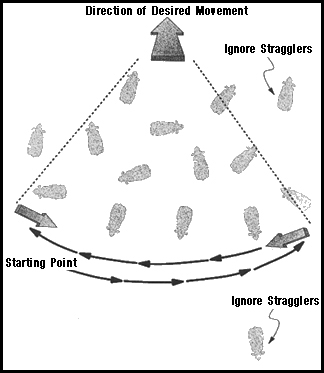
Figure 1: Handler movement to induce loose bunching of the cattle. The arc of the zig zag movement must not exceed a quarter circle. DO NOT CIRCLE AROUND the cattle. The movement should be straight or a very slight arc.
Jennifer Lanier and Mark Deesing
Department of Animal Sciences,
Colorado State University
Fort Collins, Colorado 80523
Bud Williams is a well known cattle handling expert from Alberta, Canada, who for many years has practiced and taught low stress methods for moving cattle. For those who know of Bud Williams and have watched him move cattle, or who have attended one of his many clinics held throughout Canada and the U.S., it is clear that these methods really work. What Bud does has been called magic. However, many people try these methods and become frustrated and give up because they can not make them work. It is our opinion that the problem results from instructions that are not clear.
It is the job of animal behaviorists to interpret animal behavior and translate in clear language the cause of behaviors and the underlying motivations for them. For years, we have been interested in the Bud Williams method for moving cattle because low stress methods of handling cattle are known to improve both productivity and welfare. For example in a cow-calf operation, when the animals are being moved from pastures into corrals, or in pasture rotation movements, cows that get excited and run wildly when being driven can lose their calves, or the calves can get stressed and will gain less weight. Wild, uncontrolled movement of cattle causes stress in the animals, wear and tear on equipment or fences, and a greater incidence of injuries to both handle rs and cattle. Slow, calm movement of cattle in feedlots can also lower stress, reduce sickness, and enable cattle to get back on feed faster. Cattle that run wildly down alleys into the processing area become stressed prior to the stress imposed by rest raint for normal husbandry procedures. In order to lower stress and improve productivity, calm, quiet handling of cattle in all aspects of management is very important.
The Bud Williams methods of calm, slow movement of cattle on pastures can be defined as a stimulus-response relationship. In cattle that have had no previous experience with herding, the "stimulus" is a person who simulates predator "stalking behavior", which elicits predatory "avoidance behavior" in the cattle. T he "stalking" behavior simulated by the person is similar to the behavior of a predator such as a lion or a wolf. First, the predator locates the herd. Then it begins a slow survey of the herd by walking in a circular direction around the herd looking for weak or old animals. The behavior of the predator circling the herd causes anxiety in the animals. The cattle become uneasy over an impending attack by the predator and begin to loosely bunch together. This is an instinctual HARD WIRED behavior that is wired into the animal's brain. This uneasiness and slight anxiety comes before the fear and flight elicited by an actual attack. It is important to remember before attempting to use these methods that it is anxiety that makes this technique work and not fear. When the method is first used it triggers instinctual bunching behavior. The more a person works with the cattle, the calmer they become and instincutal bunching behavior is gradually replaced with calm learned behavior.
The methods used by Bud Williams to move herds of cattle on pastures or to move cattle in large feedlot pens are easy to learn if you have patience and take your time. The handIer moves at a normal walking speed (as a stalking predator would) and there s hould be no noise such as whistling, yelling, or whip cracking. If the cattle start running, these methods will not work. This method only works on animals that are slightly anxious and not fearful to the point of flight and running to get away. If the an imals become excited in your first attempt and start running, they must be allowed to calm down for at least 30 minutes before the next attempt is made. Handler movements must be steady and deliberate with no sudden jerky movements or arm waving.
These methods work best on cattle with a fairly large flight zone. We attempted to use these methods on a large group of tame feedlot cattle with no success. It is very difficult to elicit predatory avoidance behavior in tame cattle with extensive contact with people. Tame cattle can often be moved easily by leading them. There are also time of day effects that may aid handler movements. For example, cattle that are actively grazing a pasture tend to spread out, whereas cattle resting between grazing will bunch closer together. There are three steps in the process of moving cattle on large pastures:
The handler should locate the majority of the herd and start making a series of wide back and forth movements on the edge of the herd. You should move in the pattern of a giant windshield wiper.

Figure 1: Handler movement to induce loose bunching of the cattle. The arc of the zig zag movement must not exceed a quarter circle. DO NOT CIRCLE AROUND the cattle. The movement should be straight or a very slight arc.
The handler can induce the rear animals to begin to move by giving them a "predatory" stare. This simulates the initial stalking behavior of a predator sizing up the herd. The handler should keep continuously moving back and forth. If you stop moving and linger too long in one animals' blind spot it may turn back and look at you. On open pastures, it is important to take your time. Six to twenty wide back and forth movements of 100 meters or more may be required to move the herd into a loose bunch. Handler movement patterns on large pastures and other large spaces are much larger than handler movement patterns in confined spaces such as alleys or feedlot pens. Animals spread out over large areas require larger movements than animals gathered together in smaller spaces. The handler should continuously walk back and forth and move enough to the side that the lead animals can see him.(Figure 1)
Cattle that are off to one side of the pasture will be attracted as the herd moves into a loose bunch. Animals hidden in the brush or timber will be drawn out because they seek the safety of the herd. Do not chase stragglers.
It is very important that the handler resist the urge to press the cattle into loose bunching to quickly. Remember, in this step the handler is attempting to cause slight anxiety in the animals by simulating predator "stalking" behavior. Stalking behavior causes anxiety which makes the animals want to bunch together closely for safety. This anxiety comes before the fear and flight caused by an attack by the predator. Take your time to allow the animals to bunch together and to allow calves to find their mothers(Figure 1).
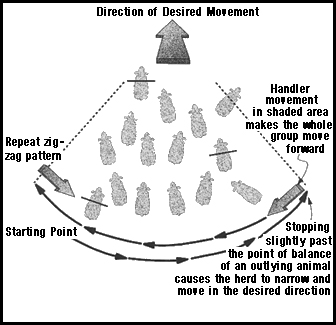
Figure 2: Initiating movement in the desired direction.
The handler continues the back and forth movements but presses closer to the herd to induce movement. This will cause the herd to move forward and begin to string out.
Handlers need to differentiate between "good" and 'bad" movement of the cattle. When cattle have "good" movement, they can easily be driven in the desired direction. When animals have good movement that are all headed in the same direction and moving s moothly. They will look like a group of animals walking to water or making some other voluntary group movement on a large pasture. In a large group of animals, "good" movement starts with one animal and additional animals will gradually follow. "Good" movement entices the other animals to follow, and bad movements prevents other animals from following in an orderly manner. There are two types of "bad" movement:
The first signs of bad movement are stopping, wavering towards motion or starting to turn away from the desired direction to look at the handler. The extreme form of type two movement is circular movement.
Good movement can be disrupted when the animals are attempting to locate the handler's position. This is a natural anti-predator behavior of prey species. They want to know where the predator is and what its intentions are. Animals will turn and look at a person or a dog that is either in their blind spot behind their rear or is out side their flight zone. Handlers should not remain more than momentarily in any individual animal's blind spot. Walking through the blind spot will not cause a problem.
To make the group move pressure has to be applied to both the collective flight zone and individual animals within the moving herd. When an animal or a group responds to the handler's pressure on the flight zone, the handlers must IMMDIATELY stop forward movement or change direction of movement to relieve pressure. This rewards the animal for moving in the desired direction and the animal is more likely to continue that movement. When the desired movement slows down, the handler must apply pressure again.
Every time you are working your animals you are training them. You can train them to be easy to handle and have good movement or you can train them to be difficult and have bad movement.
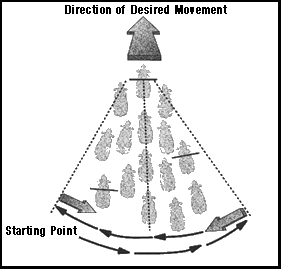
Figure 3a: To continue movement in the desired direction, the handler continues to zig-zag back and forth behind the animals.
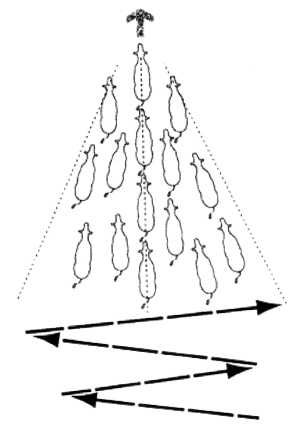
Figure 3b: Cattle should be induced to form a loose bunch before the zigzag movement is used to enter the flight zone more deeply, to start movement. Practice pressure and release on the moving group.
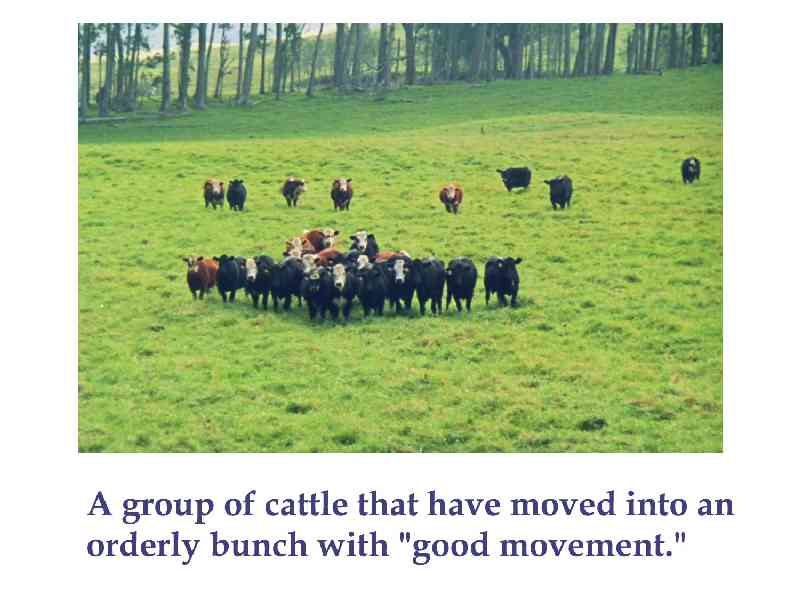
A basic principle is to alternately penetrate and withdraw from the animal's flight zone. Other movement patterns are shown on other parts of our web page, www.grandin.com.
When cattle are moved through a gate, the handler should back up and relieve pressure on the collective flight zone. Animal movement out of small paddocks and pens can be controlled by using a T-square movement.
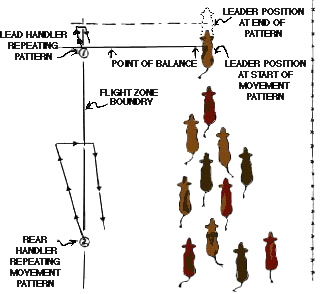
Figure 4: To speed up cattle movement, the handler should walk inside the flight zone in the OPPOSITE direction of the desired movement. When you want to slow cattle down, you walk OUTSIDE the flight zone in the SAME direction as desired movement. The vertical line in the diagram is the edge of the collective flight zone. Penetrating the flight zone will initiate movement.

Figure 5: The handler moves back and forth near the gate. He or she walks deep in the flight zone when walking in the opposite direction of desired movement and walks outside the flight zone in the same direction as desired movement. A handler in this position can act as a valve to control animal movement and help prevent broken fences. Controlling animal movements out a gate will also help prevent mother cows from losing their calves. It also trains the cattle that people control their movements.
When these methods are first used they work because they trigger the animal's hard wired behavior patterns that it uses to avoid predators. At first, a slight anxiety is produced, but if the handler is always calm, he/she can teach the cattle that they do not have to be anxious. At this point learning will take over and the handler will no longer have to rely solely on the animal's natural instincts.
When cattle are moved on pasture, they can be taught that pressure on their collective flight zone will be relieved when they go where the handler wants them to go. A calm quiet handler can also teach his or her herd that they will never be pressured to the point of being frightened.
This principle is being used by progressive ranchers to manage pastures without using fences to divide up different grazing paddocks. A herder who spends many hours on the range or pasture pressures the flight zone when the herd moves out of the designated grazing area and reduces pressure on the flight zone when the animals move back into the designated area.
Teaching a herd to graze in a desired location will be much easier if young heifers are used which are more easily trained. The most difficult herd to train would be a group of old cows from several different ranches. Some old cows have learned bad habits which are hard to change. Herding will usually be easier if "bunch quitters" and hot tempered cows that disturb the entire herd are culled.
In conclusion, one must always remember that every time you handle your cows you are training them. You can train them to be wild and stressed or you can train them to be calm and quiet. It is also advisable to train your calves that they can be handled many different ways, such as on foot or horseback and with vehicles such as four wheelers. Training your calves to tolerate several different types of calm handling will ease their adjustment to trucking and entering a feedlot.
When driving cattle with the straight zigzag movement shown in Figure 3B, the handler works just inside the flight zone. When the cattle are going where you want them to go, you back off and relieve pressure on the flight zone. When you back off and relieve pressure, you may still be in the pressure zone or zone of influence. This may be similar to Whit Hibbard's principle of maintaining contact with the cattle. The cattle are still aware of the handler and know when the handler is located. There has been much confusion about terminology. An easy way to avoid confusion is the flight zone is the zone that will initiate movement and keep cattle moving. The pressure zone is just outside the flight zone. The pressure zone will initiate loose bunching, but it does not initiate movement for driving cattle. When the handler practices pressure and release while driving cattle, the handler is inside the flight zone to induce movement, but he/she may still be in the pressure zone when they back off and relieve pressure on the flight zone to prevent cattle from running.
Derek Bailey, at Montana State University, and Floyd Reed, from the U.S. Forest Service in Delta, Colorado, have done extensive research on the use of herding methods to control where cattle graze. From their research they have learned ways to make the Bud Williams methods of low stress herding more successful. Herding is being successfully used in the rough hilly country of Colorado and Montana to control cattle grazing patterns. The principles of pressure and release are used to place the cattle. These principles have already been described in this article. Herders ride throught the cattle everyday and they become very calm and easy to handle. Following are some additional tips for success:
On rugged hilly terrain the use of herding methods to keep cows away from fragile wet lowlands (riperian areas) will be more effective if it is combined with 1) culling problem cows, 2) using cattle that have a preference for hill country, 3) timing moves to correspond with calf bed down times, and 4) placing tasty supplements in the new location.
Bailey, D., et al. 2001. Journal of Animal Science. 79: 1883-1891.
Steve Cote with the National Resources Conservation Service in Arco, Idaho has written a book which explains these methods. The training procedure must be done BEFORE the cattle are taken out on the range. He applies pressure to the flight zone of each INDIVIDUAL animal in the group. He works with the animal until it responds calmly. Each animal has pressure applied to the edge of the flight zone at the location just behind the point of balance at the shoulder. Pressure should not be applied in the blind spot behind the animal's rear or directly in front of the head. Use the positions shown as A and B on the flight zone diagram. A cow that trusts the handler will respond by walking straight instead of turning and circling. After a few minutes of calm movements, learning will start to override the turning instinct. The principle of pressure and release must be used.
Groups of cattle can also be trained using this method. Beef calves should be pre-weaned and trained to quiet group movements before they leave the ranch and go to a feedlot. Unfortunately, there are still some beef calves that are not pre-weaned and they arrive at the feedlot in a highly stressed state. They have difficulty settling down and going on feed at the feedlot. Two feedlot veterinarians in Nebraska have used Bud Williams methods to habituate their calves to people and get them to settle down and eat. Lynn Locatelli and Tom Noffsinger train feedlot receiving crews to work with newly arrived calves to calm them down and get them accustomed to closer contact with people. The handlers start by walking slowly towards a group of calves and when they first react they immediately back out of their flight zone. The handlers must be careful not to approach too quickly because this will cause the calves to run. By carefully penetrating the flight zone and then retreating, the handler will gradually reduce the size of the flight zone. The principle is to gain the calves' trust by backing off at the first sign of a reaction. After about 10 to 20 minutes, the calves will allow the handler to get closer to them without running away.
If the calves are bawling or continually walk the fence, the handler can calm them and slow down their movements by walking with them in the SAME direction as their movement. Walking calmly in the SAME direction as the movement of the calves will calm them down. Both of the techniques described here will help reduce sickness and get the cattle to go into feed more quickly. Fear stress is a powerful stresser. Reducing fear will make the calves more productive and safer to handle. Using these methods will also help calves to be calmer and less stressed after vaccinations and other procedures.
Cote, S., 2004. Stockmanship - A Powerful Tool for Grazing Land Management. Natural Resources Conservation District. Arco, Idaho.
Maday, J., 2005. Put out the Welcome Mat. Drover's Journal of Feeder Management. Supplement. Sept, pp 2-12.
On an extensive ranch with rugged terrain, very large zig zags a half mile to a mile and a half may be used. In this situation, ALL the cattle will not be able to see the handler at the same time. It is likely the head will form subbunches as the handler on a horse moves back and forth. In this situation, it would be impossible to induce the ENTIRE herd to move into a loose bunch before moving them. The subbunches can be pressured to go forward.
More information on grazing animal movement patterns
 Click here to return to the Homepage for more information on animal behavior, welfare, and care.
Click here to return to the Homepage for more information on animal behavior, welfare, and care.